There is a myth that politics in Sarawak is staid, unchanging. Implicit in this perspective is a mistaken view that Sarawakians are not agents of their political future in elections, are easily manipulated by money, not willing to change their political loyalties, or make the best decisions for their futures.
There remains a lack of understanding of and appreciation for the vibrancy and dynamism of politics in Borneo and the quiet confidence of Sarawakians.
Part 5 of my ethnic voting series focuses on Sarawak in GE15. Building on my earlier analysis of Sarawak voting, this study analyses polling station results of GE14, GE15, and the Dec 2021 Sarawak polls.
This close look at voting behaviour shows that Sarawakians are actively engaged in politics and that ethnic patterns of support are changing.
As with voting patterns found in Peninsular Malaysia, multiple ethnic communities changed their electoral support in GE15. In fact, contrary to the myth, Sarawak is a politically swinging place.
Sarawak’s national importance
Let me preface the analysis with some gentle reminders about Sarawak and Sabah’s role nationally. Given the intense competition and polarisation of Malaysian politics nationally, Borneo support is critical for national power.
This is evident in the numbers. Of the 148 seats held by Anwar’s government, 20 percent or 30 are from Sarawak. The majority are held by Gabungan Parti Sarawak (GPS), five are Sarawak DAP, one is PKR, and one is held by Parti Bangsa Malaysia (PBM).
It is also important to remember that without the seats from Sarawak and Sabah, Pakatan Harapan would not have made the electoral gains to position themselves for national power. Of the 82 seats won in GE15 by Harapan and its allies, about seven percent came from Sarawak.
Beyond the numbers, Borneo plays a crucial role in setting the country’s direction.
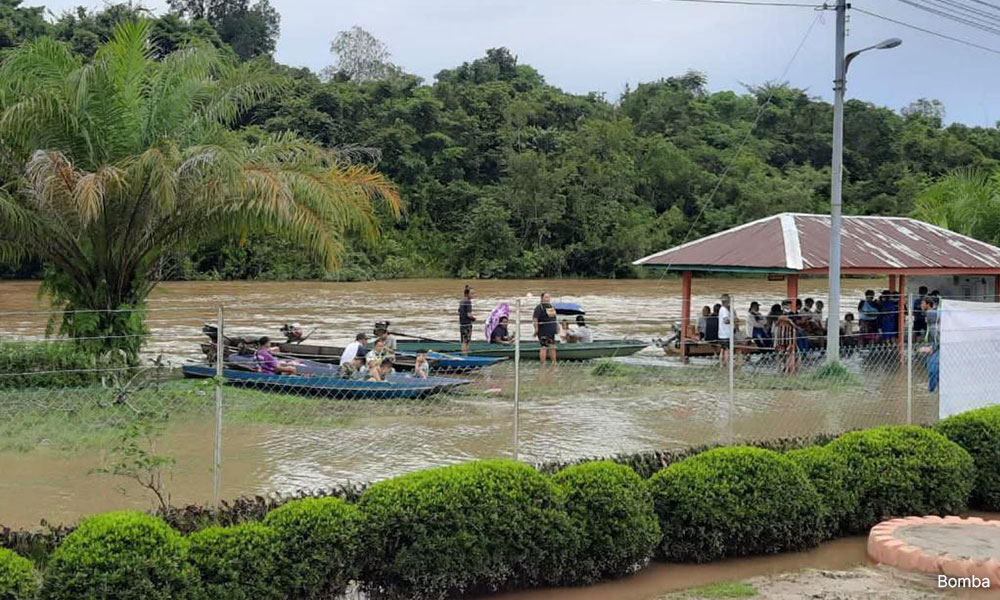
Arguably, since 2011, Sarawakians have been sending important political messages as a harbinger of change, both pressure for change and disappointment with performance, and, more recently, in a call for stability and reduced ethnic polarisation and religious extremism.
Regional nationalism with demands for greater autonomy was the main political narrative in the 2021 election, with opposition parties pushing for greater autonomy capturing 22 percent of Sarawak’s popular vote. The results would differ in the general election, as local parties became less relevant.
Overall GE15 Sarawak results
GPS did well - Premier Abang Johari Openg’s coalition won the most seats in Sarawak, 23 out of 31. What is not appreciated is the gains by others.
The opposition Sarawak DAP and younger local strongmen leaders Larry Sng Wei Shien of PBM and Ali Biju of Perikatan Nasional both gained and held onto past support.
Few appreciate that 43 percent of Sarawak voted for non-GPS alternatives, an indication that while GPS may dominate, its support is not as strong as its seat numbers imply.
The Sarawak narrative in GE15 varied; unlike the Dec 2021 polls, in GE15 (Nov 2022), calls for autonomy were replaced by contests over who voters felt best represented them on the national stage and which leaders/coalitions would deliver to communities.
Voting patterns show that a considerable number of voters opted for not concentrating their support in one coalition, namely GPS, choosing plural representation.
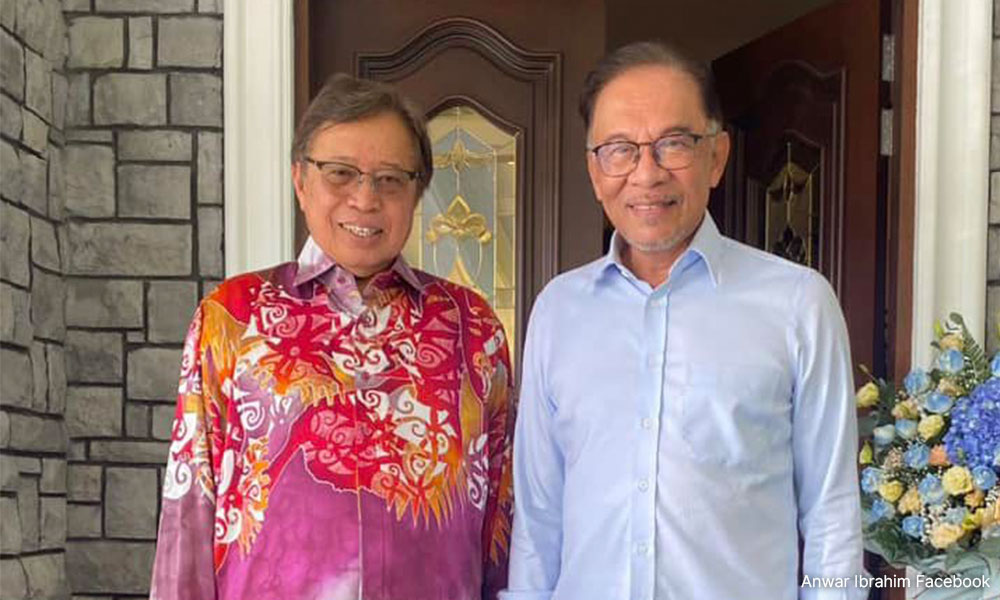
At the same time, especially given Abang Jo’s focus of the 2022 campaign around his leadership, support levels for his leadership dropped from the well-oiled campaign, good handling of the Covid-19 pandemic high of 2021.
The Sarawak results indicate that the GPS leadership, while strong, has gaps in electoral support among some communities.
Turnout variation
My analysis of Sarawak focuses on its main communities - Chinese, Sarawak Malays (different from those on the Peninsular as well as some Peninsular Malays who have settled/work in Sarawak), Melanau, Bidayuh, Iban, and other bumiputera communities.
Those communities number over 30 including Orang Ulu, Lun Bawang, Kayan, and Kelabit. These smaller groups often live in particular areas, so the sample is too small to look at Sarawak-wide voting patterns.
Also relevant for understanding ethnic voting patterns, Sarawak is majority Christian with only slightly over a third (34 percent) Muslim population.
Sarawak’s religious configuration is important in understanding the GE15 results as the intense anti-Christian religious rhetoric of PN impacted some voters, opting for the coalitions that historically have been seen to protect religious tolerance.
PN still won a seat in Sarawak, but it did so on the strength of the candidate Ali Biju, not the coalition and its messaging.
Regarding turnout, findings show a significant upturn among Chinese Sarawakians, an estimated 14 percent increase. Turnout levels for Malays/Melanaus and Bidayuh stayed the same as in the Sarawak 2021 polls, which was a drop from GE14.
The turnout of Iban and other bumiputera communities in Sarawak dropped, an estimated 69 percent to 61 percent and 58 percent to 49 percent respectively. These are not insignificant declines.
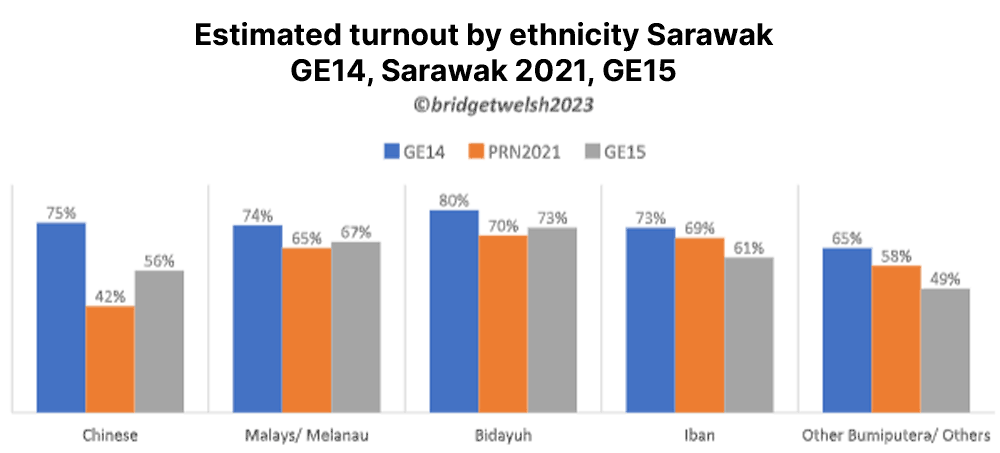
At 62 percent, Sarawak had the lowest turnout in the country in GE15. This was impacted by those who could not return home to vote. My study finds that communities that often live in more remote areas have the lowest estimated turnout among all Sarawakians.
This speaks again of the pressing need for the Election Commission (EC) to introduce postal and remote voting. Their failure to do so disenfranchises Sarawakians and particularly poorer communities in Sarawak.
Unlike in other states, Sarawakians maintain their voting in Sarawak when they move away as this is also tied to communal land rights and closely tied to maintaining their cultural identities. Current EC practices unfairly discriminate.
The turnout patterns also show that GE15 campaign issues did not resonate with the Iban and other communities compared to the other groups where turnout increased. Of the communities, Chinese turnout increased the most in GE15.
Sarawak ethnic swings
These increases in turnout were also part of a broader swing in Chinese support. Support for Harapan and Sarawak DAP more than doubled compared to the Sarawak 2021 election to an estimated 71 percent.
This is not as high as that of GE14 at an estimated 83 percent but is a significant shift. Harapan/Sarawak DAP also received an estimated 40 percent swing in support among the Bidayuh, 22 percent from the Iban, and modest swings from all other bumiputera communities.
Sarawakians largely rejected racialised rhetoric. Focus groups among Bidayuh and Chinese Sarawakians, where the swing was the most intense, point to a rejection of the anti-Christian rhetoric, a finding that was also echoed in Sabah.
Those who stoke racial tensions in Peninsular Malaysia lost support and seats in Borneo. Harapan/Sarawak DAP won seats such as Mas Gading, Miri, and Sibu due to this factor.
Also important was greater trust among these swing voters that Harapan would better represent the communities nationally compared to GPS.
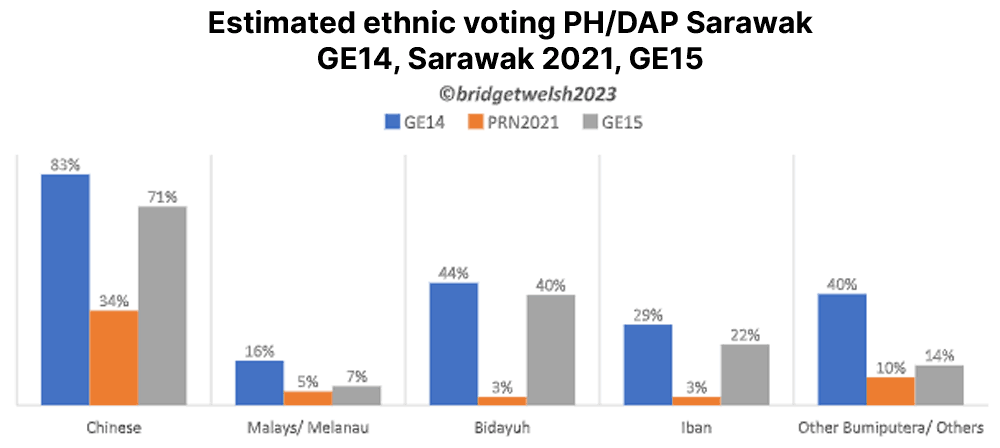
The ethnic voting findings for GPS show the erosion of this coalition’s support among Chinese and Bidayuh, an estimated 15 percent and 12 percent respectively.
GPS’ support among Chinese Sarawakian voters in GE15 is estimated higher than that of GE14, but not that of the Bidayuh.
GPS maintained the support of Malays/Melanau in GE15 and made modest estimated six percent gains among Ibans and other bumiputera. GPS as a coalition has electoral support across all of the communities, but this support is uneven and changing.
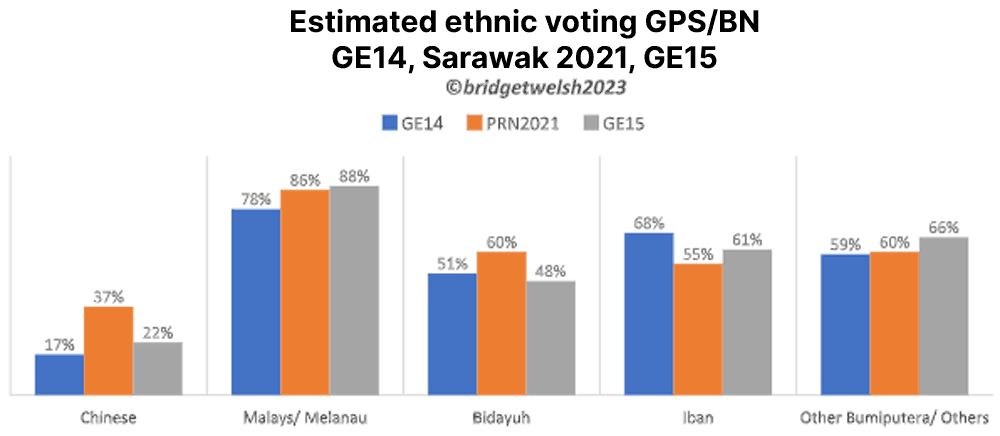
Reflecting on Sarawak results
The findings show that polarisation on the Peninsular, while rejected by Sarawakians, is also simultaneously mirrored in different ethnic patterns of voting in Sarawak itself, especially the differences among Malays/Melanau and Chinese Sarawakians.
They also show that other communities in Sarawak, notably the Iban and Bidayuh, have their own unique patterns of voting and needs for representation/governance.
And while GPS may be strong electorally, for now, its strength varies across communities. The challenge for GPS as a coalition is to assure that all of the different Sarawak communities are represented in its decisions on who to ally with and with the policies it decides to support/reject.
It is not an easy path to navigate, especially as Sarawak plays a simultaneous role in reducing national ethnic polarisation.
GPS is also keenly aware that a previous alliance with Harapan 1.0 was rejected in 2021 when voters were unhappy with Mahathir’s performance and his government’s inadequate support for Sarawak.
It is no wonder that GPS repeatedly calls for Anwar to keep his promises to Sarawak, to maintain trust in a key ally without which his government would not have a comfortable majority in Parliament.
For Sarawak DAP, having maintained most of the seats it won in 2018 (except Sarikei) it also faces the challenge of speaking out on issues in a government where it is being shut out of meetings and executive government roles, as well as having its federal constituency allocations decimated (as GPS has greater access to government revenues and patronage).
These short-sighted practices diminish the Sarawakian voters who supported Harapan/Sarawak DAP, many of the same voters who decisively punished Harapan 1.0 in the 2021 elections. They too are carefully watching how policies and practices address the needs of Sarawak and Sarawakians.
In fact, being on the sidelines of the Anwar government may be to Sarawak DAP’s advantage politically, as they position themselves for the contestation over seat delineation that is to begin as early as next year and state elections (not due until 2026). These battles still lie ahead.
The GE15 ethnic voting patterns in Sarawak show that support for different parties is changing, and with new national configurations, alliances and contests will likely change again. Sarawakians swing.
To take Sarawak and Sarawakians for granted and assume patterns will remain the same would be a mistake. The contemporary reality of Sarawak politics is that Sarawakians expect more from all of their leaders and parties, an expectation of a better and fairer government that is long overdue. - Mkini
READ : GE15 ethnic voting analysis - Part 1: An introduction
READ : GE15 ethnic voting analysis - Part 2: Who voted?
READ : GE15 voting analysis - Part 3: Hidden, pivotal Indian swing
READ : GE15 voting analysis - Part 4: The Chinese Pole
BRIDGET WELSH is an honorary research associate of the University of Nottingham, Malaysia’s Asia Research Institute (Unari). She is also a senior research associate at the Hu Fu Centre for East Asia Democratic Studies and a senior associate fellow of The Habibie Centre. Her writings can be found at bridgetwelsh.com.
The views expressed here are those of the author/contributor and do not necessarily represent the views of MMKtT.



No comments:
Post a Comment
Note: Only a member of this blog may post a comment.